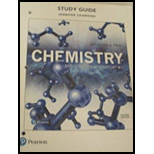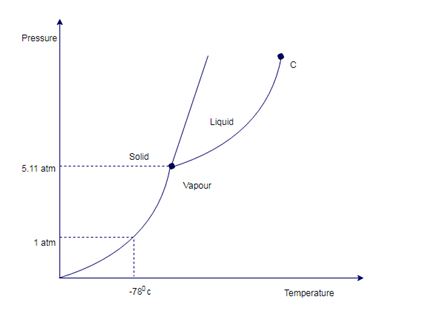
Study Guide for Chemistry: Structure and Properties
2nd Edition
ISBN: 9780134460680
Author: Nivaldo Tro
Publisher: PEARSON
expand_more
expand_more
format_list_bulleted
Question
Chapter 11, Problem 110E
Interpretation Introduction
Interpretation:
Sketch the phase diagram of carbon dioxide. It may or may not be possible to turn it into liquid by cooling it down at 1.0 atm and 25° C.
Concept introduction:
A pure substance generally has three phases at different condition. Representation of all the phases at different condition form phase diagram.
Phase diagram for carbon dioxide

Expert Solution & Answer
Want to see the full answer?
Check out a sample textbook solution
Students have asked these similar questions
Why doesn't this carry on to form a ring by deprotonating the alpha carbon and the negatively-charged carbon attacking the C=O?
6. A solution (0.0004 M) of Fe(S2CNEt2)3 (see the structural drawing below) in chloroform
has absorption bands at:
350 nm (absorbance A = 2.34);
514 nm(absorbance A = 0.0532);
Calculate the molar absorptivity values for these bands. Comment
on their possible nature (charge transfer transitions or d-d
S
N-
transitions?).
(4 points)
What is the mechanism for this?
Chapter 11 Solutions
Study Guide for Chemistry: Structure and Properties
Ch. 11 - Why do ethanol and dimethyl ether have such...Ch. 11 - Why are intermolecular forces important?Ch. 11 - Prob. 3ECh. 11 - Prob. 4ECh. 11 - Prob. 5ECh. 11 - Which factors cause transitions between the solid...Ch. 11 - Describe the relationship between the state of a...Ch. 11 - Prob. 8ECh. 11 - Prob. 9ECh. 11 - Prob. 10E
Ch. 11 - Prob. 11ECh. 11 - Prob. 12ECh. 11 - Prob. 13ECh. 11 - What is the ion-dipole force? Why is it important?Ch. 11 - Prob. 15ECh. 11 - Prob. 16ECh. 11 - What is capillary action? How does it depend on...Ch. 11 - Explain what happens during the processes of...Ch. 11 - Why is vaporization endothermic? Why is...Ch. 11 - Prob. 20ECh. 11 - What is the heat of vaporization for a liquid, and...Ch. 11 - Explain the process of dynamic equilibrium. How is...Ch. 11 - What happens to a system in dynamic equilibrium...Ch. 11 - Prob. 24ECh. 11 - Prob. 25ECh. 11 - Prob. 26ECh. 11 - Prob. 27ECh. 11 - Prob. 28ECh. 11 - Prob. 29ECh. 11 - Prob. 30ECh. 11 - Prob. 31ECh. 11 - Examine the heating curve for water in section...Ch. 11 - What is a phase diagram? What is the significance...Ch. 11 - Draw a generic phase diagram and label its...Ch. 11 - Prob. 35ECh. 11 - Determine the kinds of intermolecular forces that...Ch. 11 - Determine the kinds of intermolecular forces that...Ch. 11 - Prob. 38ECh. 11 - Arrange these compounds in order of increasing...Ch. 11 - Prob. 40ECh. 11 - Pick the compound with the highest boiling point...Ch. 11 - Pick the compound with the highest boiling point...Ch. 11 - Prob. 43ECh. 11 - Prob. 44ECh. 11 - Prob. 45ECh. 11 - Prob. 46ECh. 11 - Prob. 47ECh. 11 - Water (a) “wets” some surfaces and beads up on...Ch. 11 - The structures of two isomers of heptanes are...Ch. 11 - Prob. 50ECh. 11 - Water in a glass tube that contains grease or oil...Ch. 11 - When a thin glass tube is put into water, the...Ch. 11 - Which evaporates more quickly: 55 mL of water in a...Ch. 11 - Prob. 54ECh. 11 - Spilling room temperature water over your skin on...Ch. 11 - Prob. 56ECh. 11 - The human body obtains 915 kJ of energy from a...Ch. 11 - Prob. 58ECh. 11 - Suppose that 0.95 g of water condenses on a 75.0 g...Ch. 11 - Prob. 60ECh. 11 - Prob. 61ECh. 11 - Prob. 62ECh. 11 - Prob. 63ECh. 11 - Prob. 64ECh. 11 - How much energy is released when 65.8 g of water...Ch. 11 - Prob. 66ECh. 11 - An 8.5 g ice cube is placed into 255 g of water....Ch. 11 - Prob. 68ECh. 11 - Prob. 69ECh. 11 - Prob. 70ECh. 11 - Prob. 71ECh. 11 - Prob. 72ECh. 11 - Prob. 73ECh. 11 - Prob. 74ECh. 11 - Prob. 75ECh. 11 - The high-pressure phase diagram of ice is shown...Ch. 11 - Prob. 77ECh. 11 - Prob. 78ECh. 11 - Prob. 79ECh. 11 - How is the density of solid water compared to that...Ch. 11 - Prob. 81ECh. 11 - Prob. 82ECh. 11 - Prob. 83ECh. 11 - Prob. 84ECh. 11 - Four ice cubes at exactly 00C with a total mass of...Ch. 11 - Prob. 86ECh. 11 - Draw a heating curve (such as the one in Figure...Ch. 11 - Draw a heating curve (such as the one in Figure...Ch. 11 - Prob. 89ECh. 11 - A sealed flask contains 0.55 g of water at 280C....Ch. 11 - Prob. 91ECh. 11 - Prob. 92ECh. 11 - Prob. 93ECh. 11 - Given that the heat of fusion of water is —6.02...Ch. 11 - The heat of combustion of CH4 is 890.4 kJ/mol, and...Ch. 11 - Prob. 96ECh. 11 - Prob. 97ECh. 11 - Prob. 98ECh. 11 - Prob. 99ECh. 11 - Prob. 100ECh. 11 - Prob. 101ECh. 11 - Prob. 102ECh. 11 - Prob. 103ECh. 11 - Prob. 104ECh. 11 - Prob. 105ECh. 11 - A substance has a triple point at a temperature of...Ch. 11 - The boiling of three compounds are tabulated here....Ch. 11 - Prob. 108ECh. 11 - Based on the heating curve for water, does it take...Ch. 11 - Prob. 110ECh. 11 - Prob. 111ECh. 11 - Prob. 1SAQCh. 11 - Liquid nitrogen boils at 77 K. This image depicts...Ch. 11 - Taking intermolecular forces into account, which...Ch. 11 - What substance experiences dipole-dipole forces?...Ch. 11 - Prob. 5SAQCh. 11 - Prob. 6SAQCh. 11 - Determine the amount of heat (in kJ) required to...Ch. 11 - Prob. 8SAQCh. 11 - Prob. 9SAQCh. 11 - Prob. 10SAQCh. 11 - Prob. 11SAQCh. 11 - Determine which state this substance is in at 1...Ch. 11 - Prob. 13SAQ
Knowledge Booster
Similar questions
- For questions 1-4, consider the following complexes: [Co(CN)6], [COC14]², [Cr(H2O)6]²+ 4. Room temperature (20°C) measurement of molar magnetic susceptibility (Xm) for Fe(NH4)2(SO4)2×6H2O is 1.1888 x 102 cgs (Gaussian units). Calculate effective magnetic moment and provide a number of unpaired electrons for the iron ion. Use this number to rationalize the coordination geometry around iron center. (4 points)arrow_forward7. Describe the expected 31P and 19F (where applicable) NMR spectral patterns for the following compounds (indicate number of signals and their splitting patterns). a) tetraphenyldiphosphine Ph Ph P-P Ph Ph Ph Ph ' b) tetraphenyldiphosphine monoxide P-P-Ph Ph (2 points) (2 points c) tetrafluorophosphonium hexafluorophosphate [PF4]*[PF6]¯ (4 points)arrow_forward3. For questions 1-4, consider the following complexes: [Co(CN)6]4, [COC14]², [Cr(H2O)6]²+ Which (if any) of these complexes would be expected to display Jahn-Teller distortion? (2 points)arrow_forward
- What is Instrumental Neutron Activation and what are the advantages and disadvantages in using its applications? (I'm doing an in class assignment and need better understanding of what the instrument can be used for) Please include references so that I can better understand the application of how the instrument works!arrow_forwardWhat is Isotope Analysis and what are the advantages and disadvantages in using its applications and instrumentalization? Please include references so that I can better understand how the instrument works!arrow_forward5. Count the electrons on the following complexes and state whether they follow the 18- electron rule: (3 points) Fe(CO)5 Ni(PMe3)4 PMe3 is trimethylphosphine Mn(CO)5Brarrow_forward
- For questions 1-4, consider the following complexes: [Co(CN)6]+, [CoCl4]², [Cr(H2O)6]²+ 2. Draw the corresponding d-orbital splitting for each of the complexes; predict the spin- state (low-spin/high spin) for each of the complexes (if applicable); explain your arguments. Calculate the crystal field stabilization energy for each complex (in Ao or At). (6 points)arrow_forwardFor questions 1-4, consider the following complexes: [Co(CN)6]4, [COC14]², [Cr(H2O)6]²+ 1. Assign oxidation number to the metal, then indicate d-electron count. (3 points)arrow_forwardUsing iodometry I want to titrate a sodium thiosulfate solution and I use 15 mL. If I have 50 mL of a 0.90 M copper solution and KI, what will be the molarity of sodium thiosulfate?arrow_forward
arrow_back_ios
SEE MORE QUESTIONS
arrow_forward_ios
Recommended textbooks for you
 Chemistry: The Molecular ScienceChemistryISBN:9781285199047Author:John W. Moore, Conrad L. StanitskiPublisher:Cengage Learning
Chemistry: The Molecular ScienceChemistryISBN:9781285199047Author:John W. Moore, Conrad L. StanitskiPublisher:Cengage Learning Chemistry & Chemical ReactivityChemistryISBN:9781337399074Author:John C. Kotz, Paul M. Treichel, John Townsend, David TreichelPublisher:Cengage Learning
Chemistry & Chemical ReactivityChemistryISBN:9781337399074Author:John C. Kotz, Paul M. Treichel, John Townsend, David TreichelPublisher:Cengage Learning Chemistry & Chemical ReactivityChemistryISBN:9781133949640Author:John C. Kotz, Paul M. Treichel, John Townsend, David TreichelPublisher:Cengage Learning
Chemistry & Chemical ReactivityChemistryISBN:9781133949640Author:John C. Kotz, Paul M. Treichel, John Townsend, David TreichelPublisher:Cengage Learning Chemistry: Principles and PracticeChemistryISBN:9780534420123Author:Daniel L. Reger, Scott R. Goode, David W. Ball, Edward MercerPublisher:Cengage Learning
Chemistry: Principles and PracticeChemistryISBN:9780534420123Author:Daniel L. Reger, Scott R. Goode, David W. Ball, Edward MercerPublisher:Cengage Learning EBK A SMALL SCALE APPROACH TO ORGANIC LChemistryISBN:9781305446021Author:LampmanPublisher:CENGAGE LEARNING - CONSIGNMENT
EBK A SMALL SCALE APPROACH TO ORGANIC LChemistryISBN:9781305446021Author:LampmanPublisher:CENGAGE LEARNING - CONSIGNMENT Principles of Modern ChemistryChemistryISBN:9781305079113Author:David W. Oxtoby, H. Pat Gillis, Laurie J. ButlerPublisher:Cengage Learning
Principles of Modern ChemistryChemistryISBN:9781305079113Author:David W. Oxtoby, H. Pat Gillis, Laurie J. ButlerPublisher:Cengage Learning

Chemistry: The Molecular Science
Chemistry
ISBN:9781285199047
Author:John W. Moore, Conrad L. Stanitski
Publisher:Cengage Learning

Chemistry & Chemical Reactivity
Chemistry
ISBN:9781337399074
Author:John C. Kotz, Paul M. Treichel, John Townsend, David Treichel
Publisher:Cengage Learning

Chemistry & Chemical Reactivity
Chemistry
ISBN:9781133949640
Author:John C. Kotz, Paul M. Treichel, John Townsend, David Treichel
Publisher:Cengage Learning

Chemistry: Principles and Practice
Chemistry
ISBN:9780534420123
Author:Daniel L. Reger, Scott R. Goode, David W. Ball, Edward Mercer
Publisher:Cengage Learning

EBK A SMALL SCALE APPROACH TO ORGANIC L
Chemistry
ISBN:9781305446021
Author:Lampman
Publisher:CENGAGE LEARNING - CONSIGNMENT

Principles of Modern Chemistry
Chemistry
ISBN:9781305079113
Author:David W. Oxtoby, H. Pat Gillis, Laurie J. Butler
Publisher:Cengage Learning